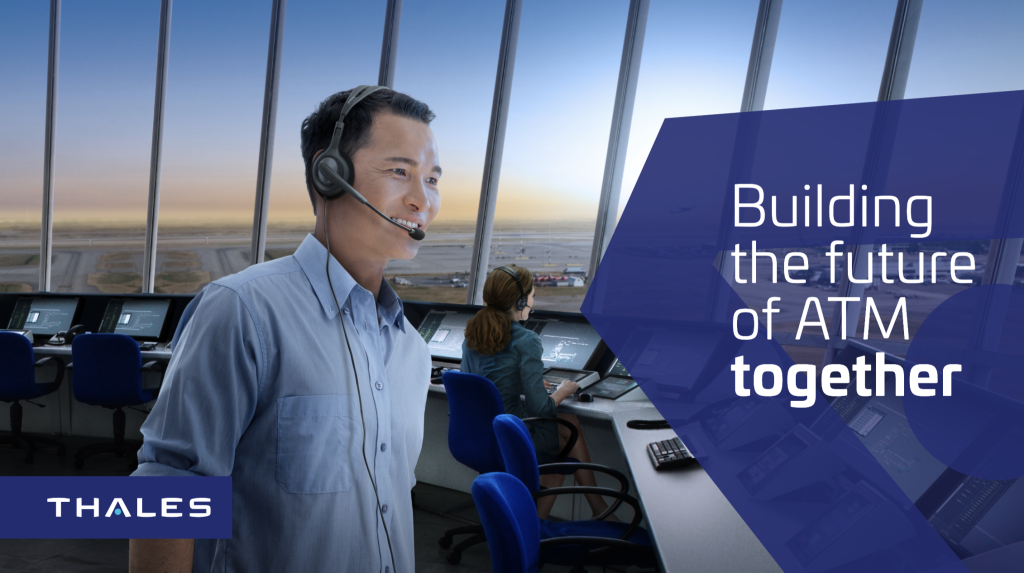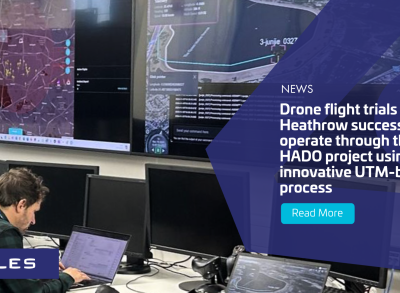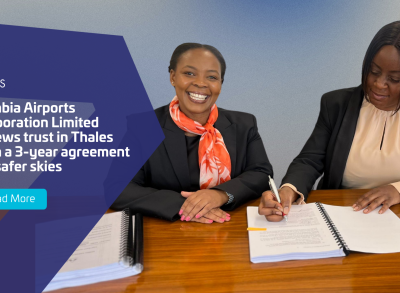Building the Future of ATM Together

Taking the opportunity to explore Open, Safe and Secure ATM
When the world was in the midst (and the worst) of the Covid-19 crisis, it was difficult to imagine that such worldwide catastrophe could potentially bring positive changes.
However, four years after the world came to a complete stop; air travel demand continues to increase much faster than previously anticipated. According to the International Air Transport Association (IATA), in 2023 international traffic had almost completely caught up with 2019 levels (88.6%)[1]. This was supposed to take five years, according to post-pandemic predictions. It took a mere two. Moreover, the disruptions passengers experienced in the year following the end of worldwide major lockdowns due to shortage of staff forced the ATM world to face the fact that its revenue model was no longer viable in an increasingly unpredictable world.
In other words, increasing the number of Air Traffic Controllers (ATCO) while decreasing the size of their areas of responsibility – to make traffic management humanly manageable – is no longer a solution in many cases. The swift post Covid-19 recovery of air travel is now conducive to take the opportunity to explore new ways to address air traffic fluctuations by opening-up the ATM world to key technological advances.
Read our article about Thales' OpenSky Platform
The race for digital harmonization
As the world continues to witness an unprecedented pace of technological innovation, the ATM sector could potentially be drawn to a wide variety of opportunities to increase its efficiency and effectiveness. From increased automation and Artificial Intelligence (AI) to big data and Internet of Things (IoT), to name a few, ATCOs could see their tasks greatly facilitated by multiple decision-making support tools.
Yet the systems on which ATCOs rely to carry out their critical task of ensuring safe flights were not designed for fast innovation. Rather, focused (as they should be) on safety, ATM systems require extensive tests in order to meet very stringent safety regulations. As a result, lead times to receive a new system can be counted in years. The same goes for the integration of any potential technological innovation in existing systems.
Additionally, as noted by the UN Conference on Trade and Development (UNCTAD): “Only a few countries currently create frontier technologies, but all countries need to prepare for them[2]." However not all countries, organisations, and stakeholders across the world have the same resources – human, financial, technological – to adapt to the pace at which technologies emerge. As a result, technological change can induce inequalities between countries in a multitude of ways.
So, in a sector as intrinsically linked as ATM, where thousands of flights cross national frontiers on an hourly basis, how can all ANSPs adapt their systems and their operational concepts to the pace of technological change in an equal manner? Moreover, how can they do so as their national authorities – and, in fact, the international economic climate – mandate that they decrease their spending?
All for one
For Thales, the answer to this conundrum is clear: cooperation between stakeholders and the reduction of the sector's digital fragmentation. If the ATM world is to evolve in unison towards a more technologically advanced future, it must move away from an "each to their own" mindset.
With TopSky - ATC upgrade, the notion of partnership is central to the ATM system’s development process and evolution.
Drawing on decades of experience in the air traffic management sector and a wide variety of customers worldwide, Thales developed TopSky - ATC on the premise that a large proportion of the functionality of an air traffic management system is common to all air navigation service providers. In other words, if, for example, more than 80% of the functionalities of an ATM system are standard and critical for everyone, wouldn't it make more sense for industry and ANSPs to join forces to define the common requirements, as well as the key technological innovations that need to be integrated to meet them? This would make it possible to focus energy on the priority development of what brings all kinds of efficiency to air navigation service providers.
To facilitate this partnership among multiple members across the world, Thales goes beyond offering a solution. It offers a new governance model.
At the decision-making level, the roadmap for the development of TopSky – ATC upgrade – and its future evolutions in the medium and longer term – is defined in partnership with all stakeholders through Alliance One, TopSky - ATC product users alliance.
Within the Alliance One, ANSPs and Thales work together to define the industry’s future Concepts of Operations (CONOPS), and corresponding critical needs, in order to create the system’s development roadmap.
The roadmap then drives technological innovations, which are developed within the Skylab Network, Thales’ network of Labs. These Labs, key pillars of the development of Thales’ strategy are being implemented in different regions of the world with the intent of pooling together stakeholder resources – both ANSPs’ and Thales’.
Finally, the delivery of TopSky - ATC upgrade, together with its technological innovations, is in fact a service business model. Rather than the one-off acquisition of a closed ATM system – and associated maintenance and upgrade costs – Thales has designed a subscription service that will allow its customers to regularly receive the upgrades they have been working on together. The regularity with which such upgrades are delivered is decided with each customer individually, depending on the evolution of customers’ needs with the guarantee that a new release is produced every 6 months. The subscription service also allows each individual customer to negotiate and, subsequently, work with Thales on the remaining part of TopSky – ATC upgrade functionalities that may be more specific to their own needs.
“This new governance allows Thales and ANSPs worldwide to work together to build the future of ATM”, says Christian Rivierre, VP Airspace Mobility Solutions at Thales.
And Alliance One for all.
“This completely new and innovative governance model guarantees the delivery of a world leading product that regularly evolves and allows customers and Thales to work together to define key domain priorities that can increase operational efficiency and return on investment”, Christian Rivierre adds. This is based on a number of synergies efficiencies brought on by the ability to work together toward a common goal.
Financial efficiency. The ability to work together in the definition of the roadmap for a product that meets multiple users’ needs allows ANSPs and Thales to pool financial resources together. This is not only for the initial development of the product but also for its evolution and integration of further technological advancements. Additionally, the subscription service also provides Alliance One members – I.e., Thales customers – to choose the level and regularity of updating that best suits their needs and meets their financial constraints.
Operational efficiency. Working in partnership in order the common core of a system’s critical needs allows TopSky - ATC customers to concentrate their efforts in the development of functionalities that will increase interoperability and controller productivity. As a result, ANSPs will be able to accommodate higher levels of air traffic flows, therefore bringing in more revenue.
Regulatory and quality efficiency. With every technological evolution, the ATM sector needs to develop, and respond to, emerging regulations that seek to ensure flight safety first and foremost. This is primarily due to the fact that, with each technological evolution, new third parties might become involved in TopSky - ATC developments and, as such, the potential for cyber security incidents increases. As a significant part of the system should common across all ANSPs, addressing the changes required to conform to new regulations is far more efficient than if this has to be done on every individual system.
Another direct consequence is that by sharing a large number of lines of code used in different contexts, the intrinsic quality and resilience of the solution is multiplied by a significant factor.
Sovereignty efficiency. Providing a distributed service offering in different regions of the world requires the development of both Thales's regional competence center and an ecosystem of industrial partners including local industry and research centres. This regional presence is a guarantee of sovereignty for the region's ANSPs for any type of crisis that might arise, as was the case during the Covid crisis.
Innovation efficiency. Thales’ SkyLab Network is a pillar of the TopSky - ATC framework not only because they allow ANSPs and Thales to work together, but also because they involve operational staff in the development of innovative solutions that will facilitate their daily tasks. By actively involving ATCOs in these technological developments, the new governance ensures that there is already a level of buy-in from the start, and that these new updates do reflect operational needs – as opposed to being primarily top-down and imposed.
Training efficiency. With a significant part of the system being common to all Alliance (One) members, Thales can train all operational staff far more efficiently than if its teams need to travel regularly to different locations for training sessions tailored to each individual ATM system. Additionally, with a number of ATCOs also actively participating in the development of the new updates, it is likely they will also be able to contribute to supporting their colleagues when new updates are rolled-out. Finally, the subscription service, which will allow updates to be released regularly, will facilitate more regular training on smaller changes – rather than much more intense training on more significant updates every few years.
Sustainability efficiency. Another unexpected positive outcome of the Covid-19 crisis has been the increased awareness, worldwide, for the need for a greener aviation sector. ANSPs and ATCOs can play a significant role in greening the industry by implementing eco-friendly operations. And where previously this may have been out of reach of certain countries due to budget and system constraints, the implementation of TopSky - ATC will allow countries to pool their resources together to contribute to a sustainable aviation sector.
Building Better Skies Together, at an affordable cost
The upgrade of TopSky - ATC is more than a solution. It is a paradigm shift in the way the industry works to address an increasingly unpredictable world. It brings key ATM stakeholders – ANSPs and industry – together for the development of a system that will allow ANSPs and ATCOs to address growing air traffic flows more efficiently across a wide variety of areas.
With partnership at its heart, Alliance One puts significant emphasis on the importance of ownership – of processes, ideas, innovations and decision-making – as an Alliance rather than as a single entity. And it ensures that technological innovations benefit everyone, rather than create inequalities, thus contributing to safer skies across national airspace and boundaries.
"Thales is committed to supporting ANSPs in designing an open, safe and secure solution that will enable them to cope more flexibly with predictable and unpredictable fluctuations in traffic flows at an affordable cost. This enables all stakeholders to work together more proactively to build better skies together. And we're very proud to have already brought major ANSPs on board with us on this journey. So stay tuned to learn more…." concludes Christian Rivierre, VP Airspace Mobility Solutions at Thales.
[1] https://www.iata.org/en/pressroom/2024-releases/2024-01-31-02/
[2] https://unctad.org/page/technology-and-innovation-report-2021





